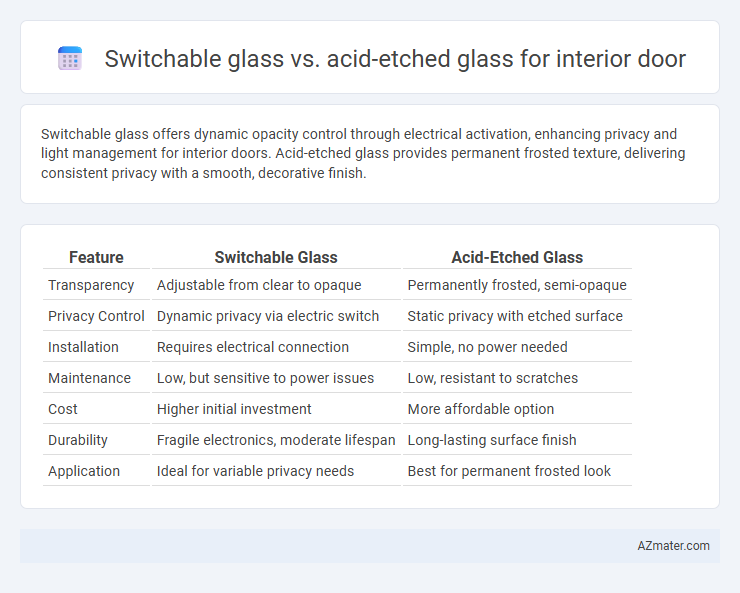Switchable glass offers dynamic opacity control through electrical activation, enhancing privacy and light management for interior doors. Acid-etched glass provides permanent frosted texture, delivering consistent privacy with a smooth, decorative finish.
Table of Comparison
| Feature | Switchable Glass | Acid-Etched Glass |
|---|---|---|
| Transparency | Adjustable from clear to opaque | Permanently frosted, semi-opaque |
| Privacy Control | Dynamic privacy via electric switch | Static privacy with etched surface |
| Installation | Requires electrical connection | Simple, no power needed |
| Maintenance | Low, but sensitive to power issues | Low, resistant to scratches |
| Cost | Higher initial investment | More affordable option |
| Durability | Fragile electronics, moderate lifespan | Long-lasting surface finish |
| Application | Ideal for variable privacy needs | Best for permanent frosted look |
Introduction to Switchable and Acid-Etched Glass
Switchable glass, also known as smart glass, uses electrochromic technology to change from transparent to opaque with an electric current, offering privacy on demand and energy efficiency. Acid-etched glass features a permanent frosted surface created through acid treatment, providing consistent privacy and a matte, decorative finish without the need for electrical components. Both are popular choices for interior doors, with switchable glass offering dynamic control and acid-etched glass delivering a classic, low-maintenance privacy solution.
How Switchable Glass Works for Interior Doors
Switchable glass for interior doors utilizes liquid crystal technology that changes from opaque to transparent when an electric current is applied, offering customizable privacy. Unlike acid-etched glass that permanently diffuses light and provides fixed privacy, switchable glass adapts instantly to changing privacy needs without obstructing natural light. This smart glass enhances interior design flexibility by controlling visibility through the door with a simple switch or remote control.
Understanding Acid-Etched Glass in Interior Applications
Acid-etched glass offers a durable, matte finish that provides consistent privacy while allowing natural light to diffuse softly through interior doors, making it ideal for creating a subtle separation between spaces. Unlike switchable glass, which changes opacity with electrical activation, acid-etched glass maintains a permanent frosted appearance without requiring power or maintenance. Its scratch-resistant, easy-to-clean surface ensures long-lasting aesthetics, enhancing both functionality and design in residential and commercial interiors.
Privacy Solutions: Switchable vs Acid-Etched Glass
Switchable glass offers dynamic privacy control by instantly toggling between transparent and opaque states, ideal for adaptable interior door applications. Acid-etched glass provides permanent diffusion, ensuring consistent privacy through a frosted, translucent finish but lacks flexibility. For spaces requiring versatile privacy solutions, switchable glass outperforms acid-etched glass with its smart, on-demand opacity adjustments.
Light Control and Energy Efficiency Comparison
Switchable glass offers dynamic light control by adjusting opacity from transparent to opaque instantly, enhancing privacy while allowing natural light modulation. Acid-etched glass provides a permanent frosted effect that diffuses light evenly but lacks variable transparency, reducing flexibility in light management. In terms of energy efficiency, switchable glass can improve insulation and reduce HVAC costs by controlling solar heat gain, whereas acid-etched glass primarily affects aesthetics and light diffusion without significant thermal benefits.
Aesthetic Appeal and Customization Options
Switchable glass offers dynamic control over privacy and transparency, allowing users to instantly change the look of interior doors from clear to frosted with an electric switch, enhancing modern aesthetic appeal. Acid-etched glass provides a permanent frosted finish with intricate patterns and textures, offering timeless elegance and customization through various etching techniques and designs. Both options elevate interior doors but switchable glass suits adaptable, tech-driven spaces, while acid-etched glass excels in artistic, handcrafted visual enhancements.
Durability and Maintenance Considerations
Switchable glass for interior doors offers high durability due to its laminated structure and embedded liquid crystal technology, resisting scratches and maintaining clarity with minimal maintenance. Acid-etched glass features a more fragile surface that can show scratches and wear over time, requiring careful cleaning and occasional refinishing to preserve its matte appearance. Both options demand regular cleaning, but switchable glass typically withstands cleaning agents better, reducing long-term maintenance needs for busy interior environments.
Installation Process and Compatibility
Switchable glass requires integration with electrical components during installation, including wiring a power source and control system, which can extend the setup time and demands skilled technicians. Acid-etched glass features a straightforward installation process similar to standard glass panels, with no electrical requirements, making it compatible with most existing door frames and hardware. Compatibility-wise, switchable glass works best with doors designed to accommodate wiring and power access, whereas acid-etched glass offers greater flexibility for traditional interior door designs without modifications.
Cost Analysis: Initial Investment and Long-Term Value
Switchable glass initially costs significantly more than acid-etched glass due to advanced technology integration and electrical components, typically ranging from $150 to $200 per square foot compared to acid-etched glass at $30 to $50 per square foot. Over time, switchable glass offers enhanced long-term value through energy savings, privacy control without additional treatments, and increased property appeal, potentially reducing utility expenses by up to 20%. Acid-etched glass presents a lower upfront expense but lacks dynamic functionality, leading to possible recurring costs for additional window treatments and limited adaptability for evolving aesthetic or functional needs.
Choosing the Best Glass Type for Your Interior Doors
Switchable glass offers dynamic privacy control by electronically changing from transparent to opaque, making it ideal for versatile interior door applications requiring adjustable light and visibility. Acid-etched glass provides a permanent frosted effect that ensures consistent privacy and diffuses light evenly, suitable for settings prioritizing aesthetics and low maintenance. Choosing the best glass type depends on your needs for privacy flexibility, light control, energy consumption, and budget constraints in your interior door design.

Infographic: Switchable glass vs Acid-etched glass for Interior door
 azmater.com
azmater.com